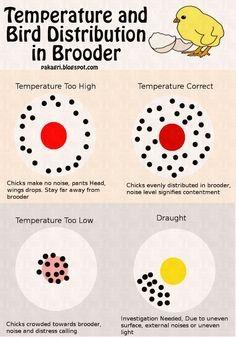Younger birds, while very cute and comical to watch grow, require more attention to manage, with temperature being the number one concern. Temperatures must remain very warm until the chicks mature because they are unable to regulate their body temperature. Young poultry requires supplemental heat for at least the first three to five weeks (Sander et al., 1999). Have temperatures set at 90°F upon hatching (exact temperature will vary with different species).
Decrease the temperatures five degrees each week until 70°F is reached (Clauer, 1997). Do not expose young birds to outside elements until they have grown in their permanent feathers. It is important to expose young birds gradually to decreasing temperatures because young poultry do not handle large temperature changes well and stress easily. Make sure to also have feed and water available.

An excellent way to raise young poultry is to set up a brooding area. A brooding area separates and protects young birds from older birds. Because young poultry must be supplied with supplemental heat, placing young birds in a brooder will help young birds maintain their body temperature. Along with providing heat, a brooder is an excellent way to make sure young poultry are supplied with all necessities to achieve optimum production: heat source, fresh feed and water, and a dry environment. Within the brooding area, feeders and waterers should be spaced apart to prevent overcrowding when feeding.